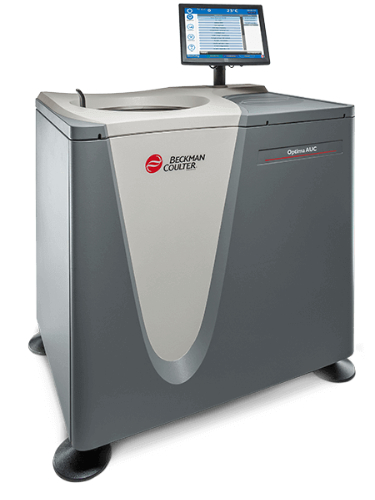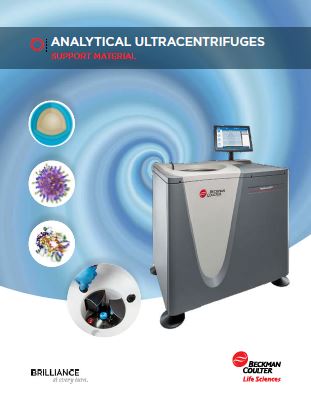Analytical ultracentrifugation – ideal for characterizing dispersed macromolecules and nanoparticles
in biopharmaceutical research, development and quality control

For almost a century, analytical ultracentrifugation (AUC) has been one the most versatile and accurate methods available to characterize proteins, macromolecules, nanoparticles and other heterogeneous solutions. It provides data for the determination of molecular weights and the weights of complexes as well as size, size distribution, stoichiometry and many thermodynamic parameters. This technology delivers a wide spectrum of data for molecules and particles moving freely, either in the formulation buffer or solvent. As an orthogonal method, analytical ultracentrifugation provides further information for methods such as size-exclusion chromatography (HPLC-SEC), light scattering methods, mass spectrometry or electron microscopy, thus allowing for a highly optimized method validation.
The Optima AUC with its new multi-wavelength absorbance optics, resulting from decades of innovation and research at Beckman Coulter, has led to an entirely new generation of analytical ultracentrifuges. See for yourself.
AUC in basic research, drug development and quality control
Viral payload
The analytical ultracentrifuge is essential for determining the genetic payload of adeno-associated viruses (AAV) and other viral vectors for drug delivery.
Protein characterization
AUC is the gold standard for determining the molar mass and the purity of a sample, and is ideal for characterizing conformational changes, homogeneity and shape.
Drug conjugation
AUC is routinely used to characterize the conjugation efficiency of antibody-drug conjugates (ADCs) and to encapsulate or fusion nanoparticle-drug complexes.
Formulation studies
Analytical ultracentrifugation is a method performed in solution that gives researchers a free choice of buffers, and is often used for titration and formulation studies.
Protein aggregation
When using analytical ultracentrifuges to investigate proteins, the focus is usually on structure and stability. AUC is a great way to study non-covalent aggregation under native conditions.
Nanoparticles
In basic research and drug development, scientists often investigate the size and shape of nanoparticles with and without drug conjugates. Nanoparticle characterization is also important for polymer research.
Drug testing
Analytical ultracentrifugation is used for the quality control of active pharmaceutical ingredients (APIs) as well as for the product release of biopharmaceutical drugs and for drug stability studies. AUC is an excellent alternative to size-exclusion chromatography (SEC).
Reference standards
The biopharmaceutical industry also uses AUC to verify and evaluate reference standards.
Advantages and application areas of analytical ultracentrifugation
Advantages over other methods:
- Matrix-free
- No standards required
- No dilution required
- Minimal buffer restrictions
- Extremely high resolution
- Detection at low concentrations
- Low sample volumes (from 0.1 ml)
- Recovery of the sample
Application areas:
- Molecular weight
- Stoichiometry
- Protein aggregation
- Protein-protein interactions
- Ligand binding
- Conjugation efficiency
- Polydispersity
- and many more…
An introduction to analytical ultracentrifugation
In an analytical ultracentrifuge, macromolecules are characterized by optical measurement while moving freely in solution at up to 60,000 rpm, which is ideal even for weakly interacting systems.
The Optima AUC combines the power of an ultracentrifuge to provide sedimentation of particles and the functionality of optical modules to detect the sedimentation over time. Innovations in optical systems, such as multi-wavelength detection, enable more precise measurements and more accurate data analyses. AUC technology provides insight into sample molecular weight, shape, conformation, and heterogeneity.
Saving the best for last: Over 60 pages of valuable know-how just for you

Life Sciences Division Headquarters
5350 Lakeview Parkway S Drive
Indianapolis, IN 46268
United States
Copyright/Trademark
Legal
Online Terms of Use
Privacy Statement
Do not sell personal data
Imprint
NOT ALL PRODUCTS ARE AVAILABLE IN ALL COUNTRIES.
PRODUCT AVAILABILITY AND REGULATORY STATUS DEPENDS ON COUNTRY REGISTRATION PER APPLICABLE REGULATIONS
The listed regulatory status for products correspond to one of the below:
IVD: In Vitro Diagnostic Products. These products are labeled "For In Vitro Diagnostic Use."
ASR: Analyte Specific Reagents. These reagents are labeled "Analyte Specific Reagents. Analytical and performance characteristics are not established."
CE: Products intended for in vitro diagnostic use and conforming to European Directive (98/79/EC). (Note: Devices may be CE marked to other directives than (98/79/EC)
RUO: Research Use Only. These products are labeled "For Research Use Only. Not for use in diagnostic procedures."
LUO: Laboratory Use Only. These products are labeled "For Laboratory Use Only."
No Regulatory Status: Non-Medical Device or non-regulated articles. Not for use in diagnostic or therapeutic procedures.
© 2000 - 2025 Beckman Coulter, Inc. All rights reserved. Beckman Coulter, the stylized logo, and the Beckman Coulter product and service marks mentioned herein are trademarks or registered trademarks of Beckman Coulter, Inc. in the United States and other countries. All other trademarks are the property of their respective owners.
